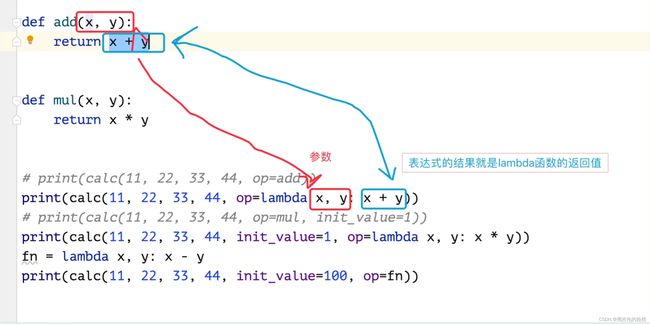2022.12.23-Python100day-day05-函数
1、写一个函数,传入一个文件名,返回这个文件的后缀名
例如: hello.py ----> py/.py
def get_suffix(filename:str, *, has_dot: bool=True)->str: """ 获取文件的后缀名 写在 * 前面的参数 称为 位置参数 * 后面的参数 称为 命名关键字参数 :param filename: 文件名 :param has_dot: 后缀名是否包含 . :return:后缀名 """ position = filename.rfind('.') # 先找到. 的位置 if position <= 0: return '' if not has_dot: position = position + 1 # 看看是否需要 . 如果想要从 position 开始切片 如果不想要 从 position+1 开始切片 return filename[position:] if pos > 0: return filename[pos+1:] # . 的位置往后的内容 return ''
if __name__ =="__main__":
print(get_suffix('hello.py'))
print(get_suffix(filename='hello.py', has_dot=True))
print(get_suffix('hello.py.txt'))
print(get_suffix(filename='hello.py.txt', has_dot=True))
print(get_suffix(filename='hello'))
print(get_suffix(filename='hello.'))
print(get_suffix(filename='.hello'))
在设计函数的时候 函数的参数个数是暂时 无法确定的 *args -----> 可变参数 可以接受零个 或者 任意 多个 位置参数 -----> 将所有的位置参数打包成一个元组 **kwargs -----> 可以接受 0个 或者 任意 多个 关键字参数 -----> 将所有的关键字参数打包成一个字典 位置参数---> position argument 关键字参数----> keywords argument 给关键字参数赋值时,需要按照字典的方式去进行赋值 关键字参数 在 位置参数 的 后面的
def add(*args, **kwargs):
print(args, type(args))
print(kwargs, type(kwargs))
total = 0
for arg in args:
if type(arg) in (int, float):
total += arg
for value in kwargs.values():
if type(value) in (int, float):
total += value
return total
print(add()) print(add(1)) print(add(1, 2, c=3, b=2.5, a=1, d='hello')) print(add(1, '2', 3)) print(add(1, 2, 3, 4))
运算符 从程序里面剥离出来 fn -----> 一个实现二元运算的函数(可以做任意的二元运算) python中的一等函数: 1、函数可以作为函数的参数 2、函数可以作为函数的返回值 3、函数可以赋值给变量 def calculate(init_value, fn, *args, **kwargs): total = init_value for arg in args: if type(arg) in (int, float): total = fn(total, arg) for value in kwargs.values(): if type(value) in (int, float): total += fn(total, value) return total def add(x, y): return x + y def mul(x, y): return x * y def sub(x, y): return x - y print(calculate(0, add, 11, 22, 33, 44)) print(calculate(1, mul, 11, 22, 33, 44)) print(calculate(100, sub, 11, 22, 33, 44))
2、lambda: 没有名字 而且 一句话 就能写完的函数 唯一的表达式 就是函数 的 返回值
3、排序算法
def bubble_sort(items: list, ascending: bool = True, gt=lambda x, y: x > y) -> list: """ 冒泡排序的算法 :param items: 待排序的列表 :param ascending: 是否使用升序排列 :param gt: 比较两个元素大小的函数 :return: 排序后的列表 """ items = items[:] for i in range(1, len(items)): swapped = False for j in range(0, len(items) - 1): if gt(items[j], items[j+1]): items[j], items[j+1] = items[j+1], items[j] swapped = True if not swapped: break if not ascending: # 是否是升序 还是 降序 items = items[::-1] return items
def seq_search(items:list, key) -> int:
"""
顺序查找(浙近时间复杂度 O(n))
:param items: 待查找的列表
:param key: 要查找的元素
:return: 找到 返回元素的索引 找不到就返回 -1
"""
for index, item in enumerate(items):
if item == key:
return index
return -1
补充:
1 return, 如果什么都不接的话,其实就是void类型函数的返回,返回后不再执行return后面的语句
如果函数执行成功返回0,不成功返回非0,一般情况下非0值常用-1来表示。
2 return 0:一般用在主函数结束时,表示程序正常终止,即告诉系统程序正常。
3 return -1::表示返回一个代数值,一般用在子函数结尾。表示程序异常终止,即告诉系统程序异常
4 return 1:与return -1相同
————————————————
版权声明:本补充部分为CSDN博主「IT_job」的原创文章,遵循CC 4.0 BY-SA版权协议,转载请附上原文出处链接及本声明。
原文链接:https://blog.csdn.net/IT_job/article/details/79132940
def bin_search(items:list, key) -> int:
"""
是对顺序列表进行查找
二分查找(浙近时间复杂度 O(log2 n))
:param items:待查找的列表(元素有序)
:param key:要找的元素
:return:找到 返回元素的索引 找不到返回-1
"""
start = 0
end = len(items) - 1
while start <= end:
mid = (start + end) // 2
if key > items[mid]:
start = mid + 1
elif key < items[mid]:
end = mid - 1
else:
return mid
return -1
if __name__ == '__main__':
nums = [35, 96, 12, 78, 56, 64, 39, 80]
print(bubble_sort(nums, ascending=True))
print(nums)
words = ['apple', 'watermelon', 'hello', 'zoo', 'internationalization']
print(bubble_sort(words, gt=lambda x, y: len(x) > len(y), ascending=False))
print(words)
nums2 = [12, 25, 39, 56, 64, 78, 80, 96]
print(seq_search(nums, 12))
print(seq_search(nums, 80))
print(seq_search(nums, 95))
print('-' * 10)
print(bin_search(nums2, 12))
print(bin_search(nums2, 80))
print(bin_search(nums2, 95))
4、函数栈
5、递归函数
递归函数 函数调用栈 的 空间 如果无限制的 会占用 满 调用栈的 空间, 函数的会报错的 不管函数 是调用 别的函数 还是调用自身,一定要做到快速收敛 在比较有限地调用次数内 能够 结束 不能无限制的进行调用 递归函数的两个要点: 1、递归公式(n次和n-1次的关系) 2、收敛条件(什么时候会停止递归函数的调用)
def foo():
print('foo')
def bar():
foo()
print('bar')
def main():
a, b = 5, 10
bar()
print(a, b)
print('game over!')
def fac(num: int) -> int:
if num == 0:
return 1
return num * fac(num-1)
if __name__ == '__main__':
# main()
for i in range(10):
print(i, fac(i))

